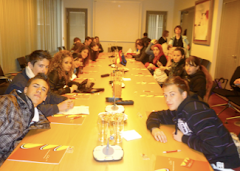On Tuesday 13th April the Austrian people prepared a special English lesson to talk about some famous meals of the Austrian cuisine.
We discussed in pairs, Austrian and Spanish, about the differences between what it is common to eat in Austria and Spain.
We also talked about the times people usually have their meals in each country.

Austrian people taught us how to make things like pancakes, apricot dumplings and veal escallops, it was great fun!
Then the teacher gave us a photocopy and we had to match all the pictures with their correct names.
After the game, the teacher cook a sachertorte (the most typical dessert in Austria), and all the students tasted it, it was absolutely delicious!
Here is the recipe of sachertorte:
This torte has become the symbol of Viennese confectionery worldwide.
For 1 Sachertorte base:
4 oz couverture 1/2 cup soft butter 1/4 cup + 2 teaspoons confectioners' sugar 6 eggs, separated 1/2 cup + 2 tablespoons sugar 1 cup flour, sifted
For the icing:
2 cups sugar 3/4 cup water 13 oz couverture, chopped
You will also need:
9-inch springform pan Parchment paper About 3/4 cup apricot jam for filling and spreading
Preheat the oven to 350F. To make the batter, melt the couverture in a double boiler over hot water. Cream the soft butter and confectioners' sugar with the couverture tempered at 89F. Stir in the egg yolks one at a time. In a clean bowl, whip the egg whites and sugar until stiff. Combine the two mixtures and fold in the sifted flour. Line the base of a springform pan with parchment paper. Spoon in the batter and smooth the top. Bake for 55 minutes. Allow to cool. Invert the pan onto parchment paper dusted lightly with sugar. Use a small knife to ease the torte from the sides, and remove from the pan. Cut the base in half horizontally. Heat and strain the jam, and use half to sandwich the two layers together. Place the torte on a piece of cardboard cut to the same size. Coat the torte thinly with the remainder of the hot jam. Gently emphasize the rounded edges of the top. The apricot masking is a base for the icing. It also helps to keep the cake moist and the chocolate glossy.
The recipe for the chocolate icing is generous enough for two tortes. To get a really smooth surface, the icing has to be poured over the torte as shown in the pictures opposite. A certain amount always sticks to the pan, strainer, and table top. It can be scraped up and used again after reheating. Place the iced torte immediately on a firm base and set aside. When the icing has set hard, use a small knife to trim the sides where it has run. Carefully slip a clean damp palette knife under the torte to release it and place on a cake plate.
A big copper pan is still used in the Hotel Sacher to melt the couverture. Master confectioner Friedrich Pfliegler can test the temperature of couverture between his finger and thumb as accurately as a thermometer. with his experience, there is no question of a mistake.
Nerea
The Spanish Lesson
First of all, when we arrived at the classroom the teacher gave us one piece of paper each. There were some questions about ourselves, like: what are your hobbies… what do we like, dislike… etc.
So, the activity was done in groups of four people. Then we had to do a small interview, asking the Austrian people. They had to tell us what they want to do in their future, what is the sport that they like most… etc. When we finished our small interview the Austrian people interviewed us. We had to tell them things we like to do on the weekends, what are our favourite colours, what we do in our free time, and things like this.
In conclusion, we, the Spanish students, learned many many things about the Austrian people and the Austrian found out a lot about our habits and hobbies.
by Carol
